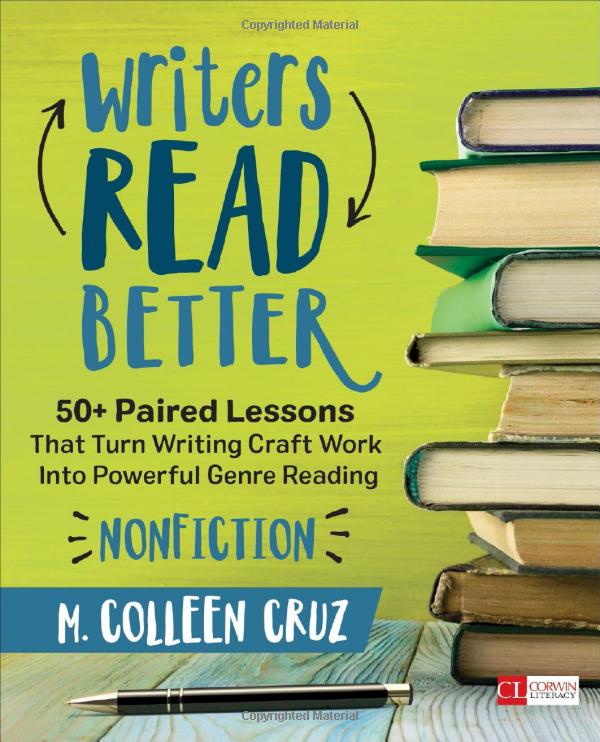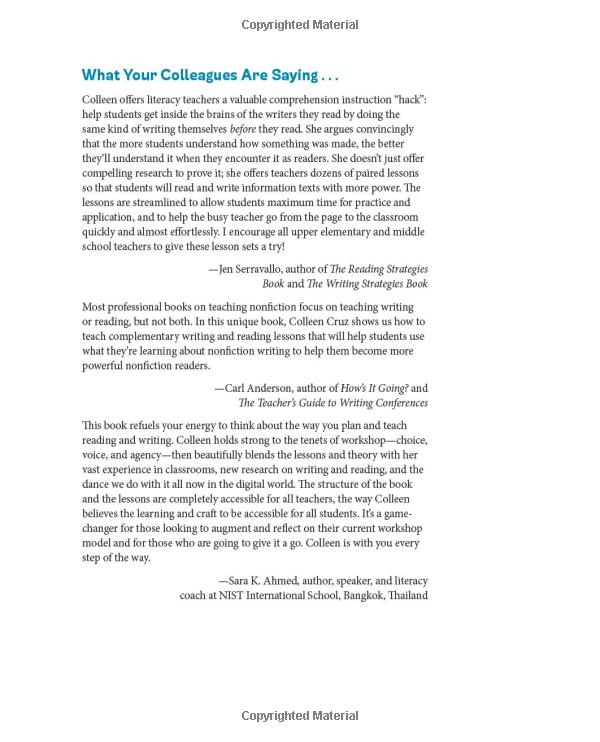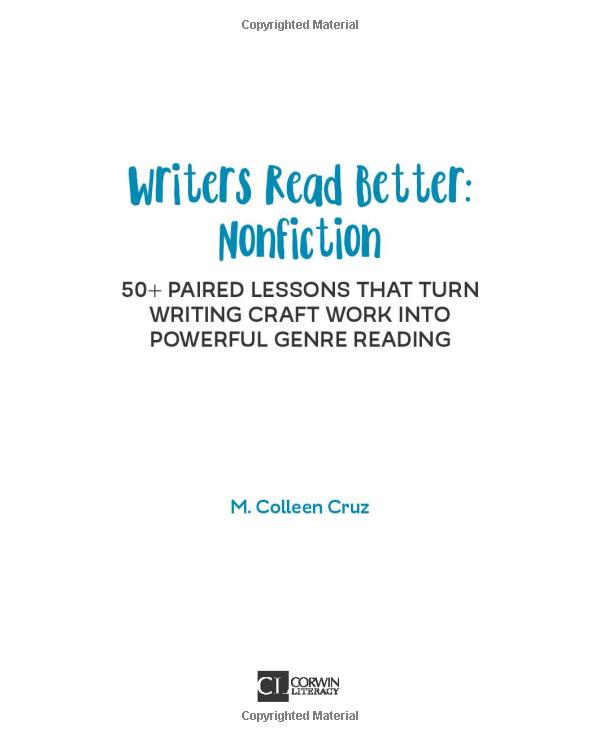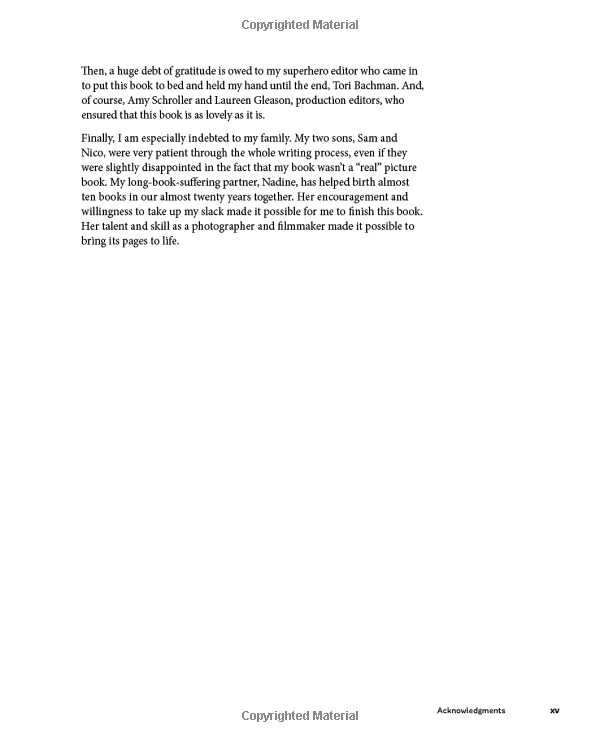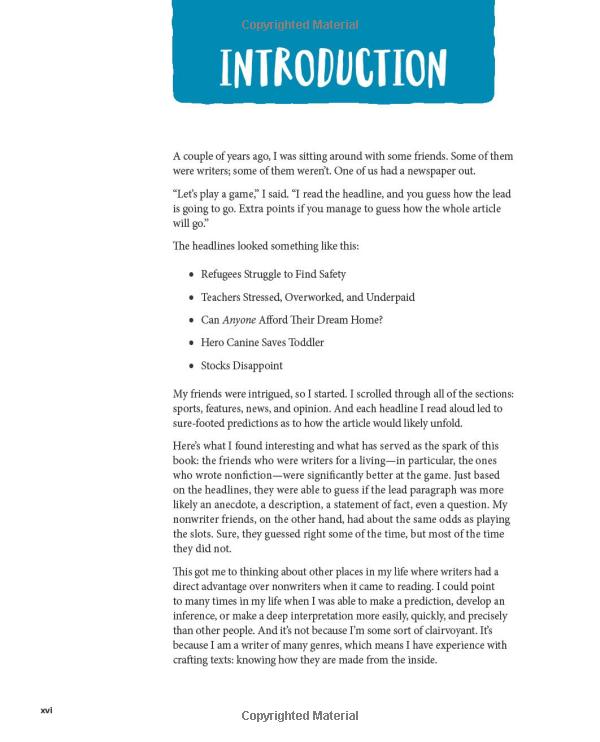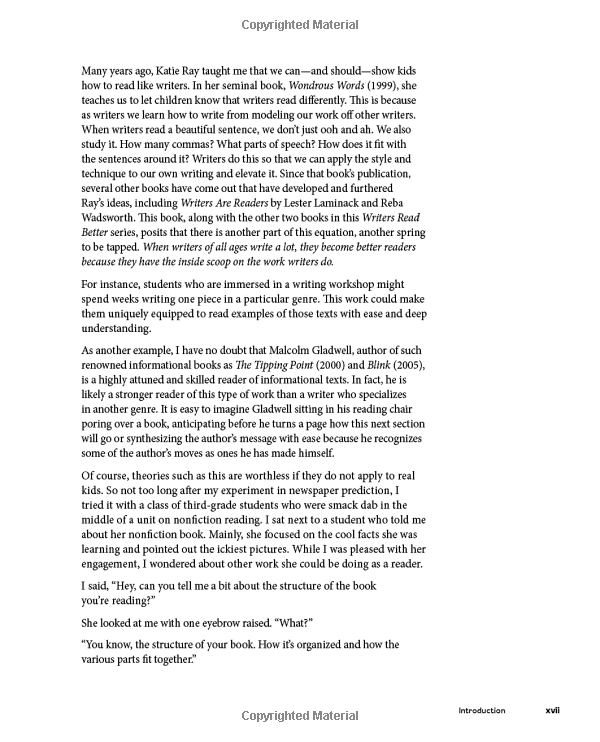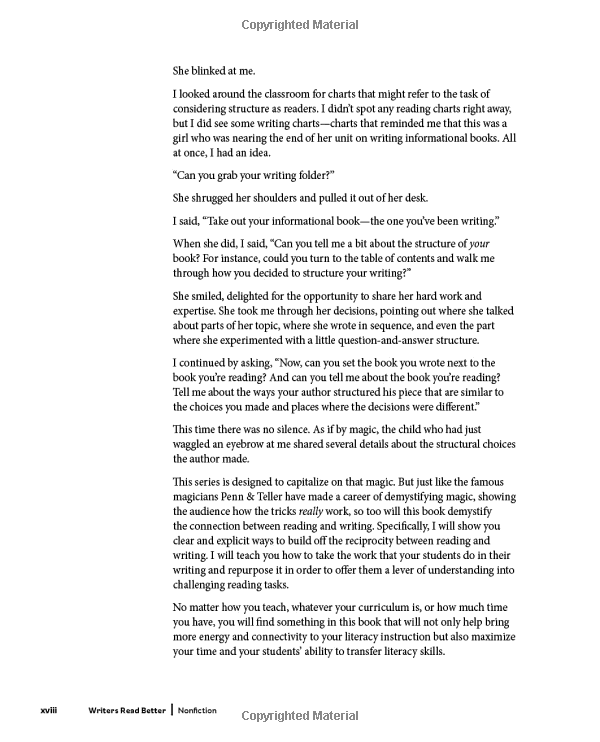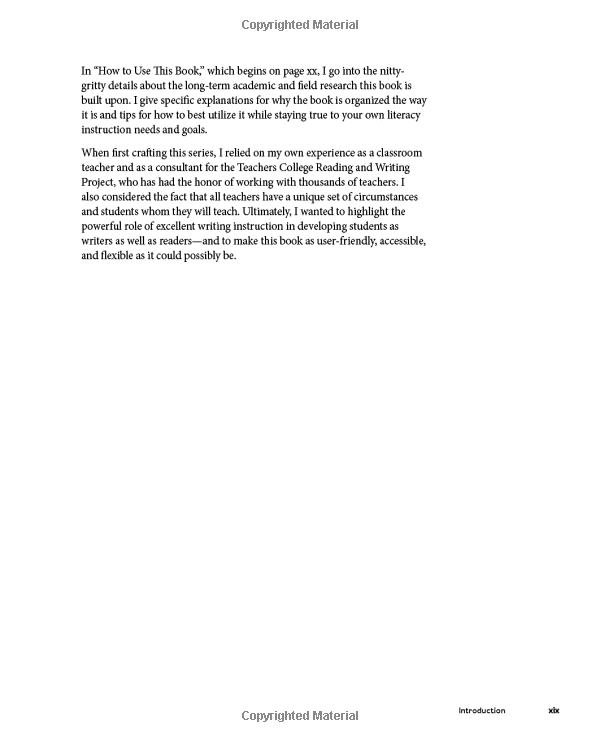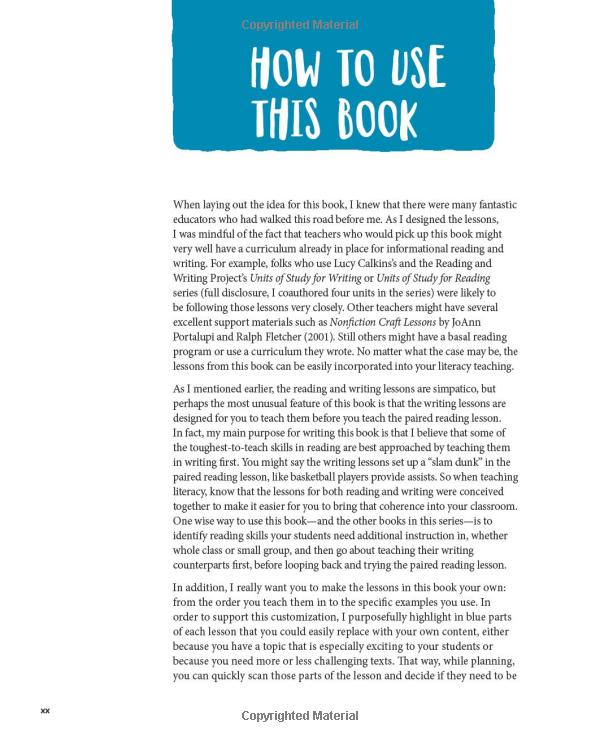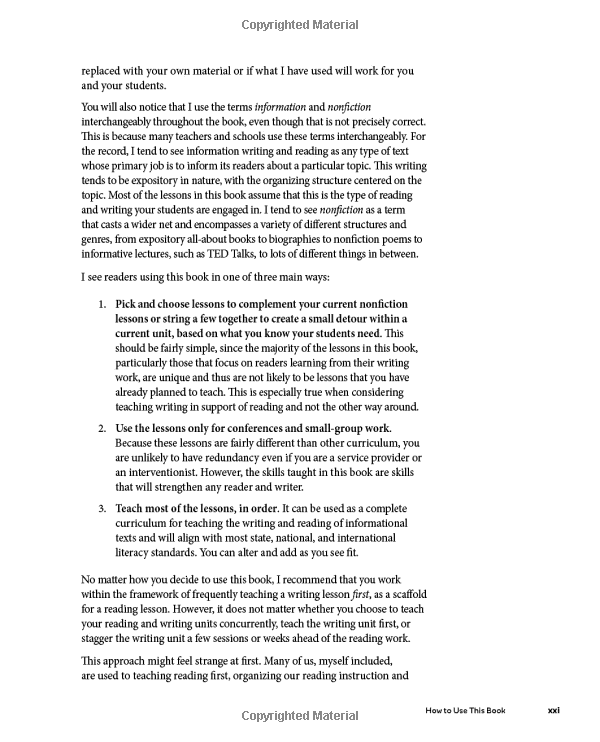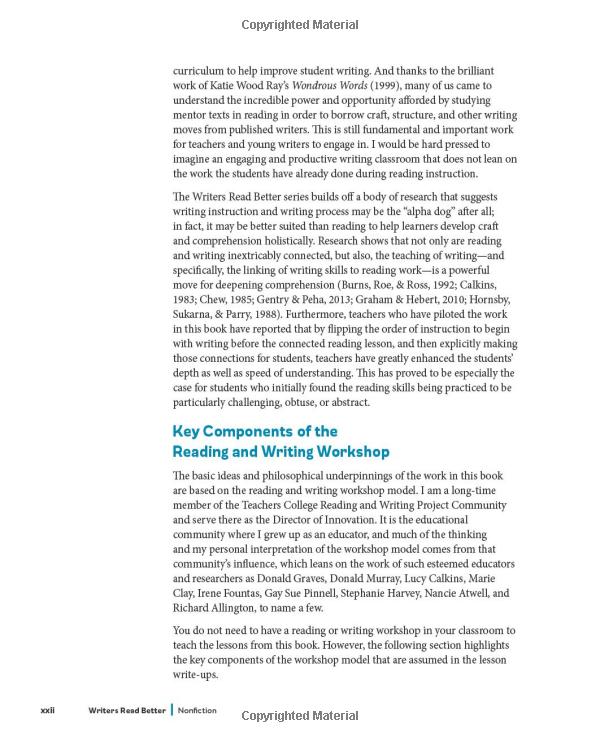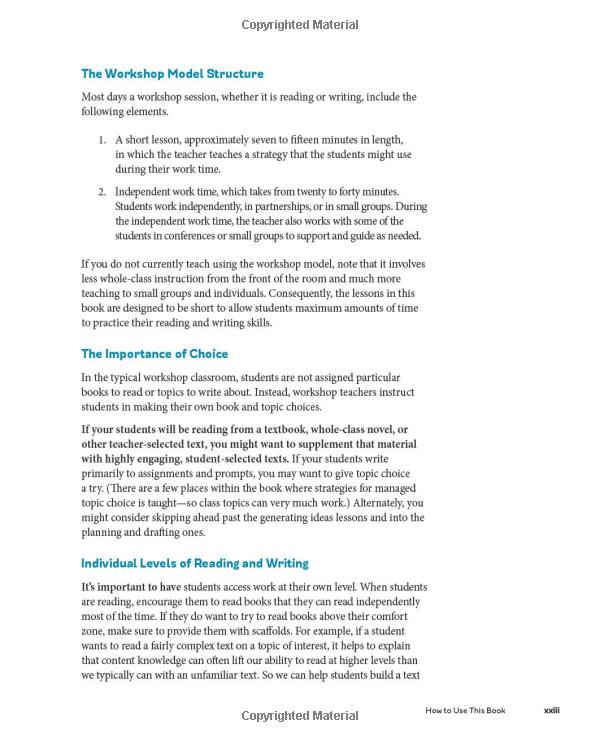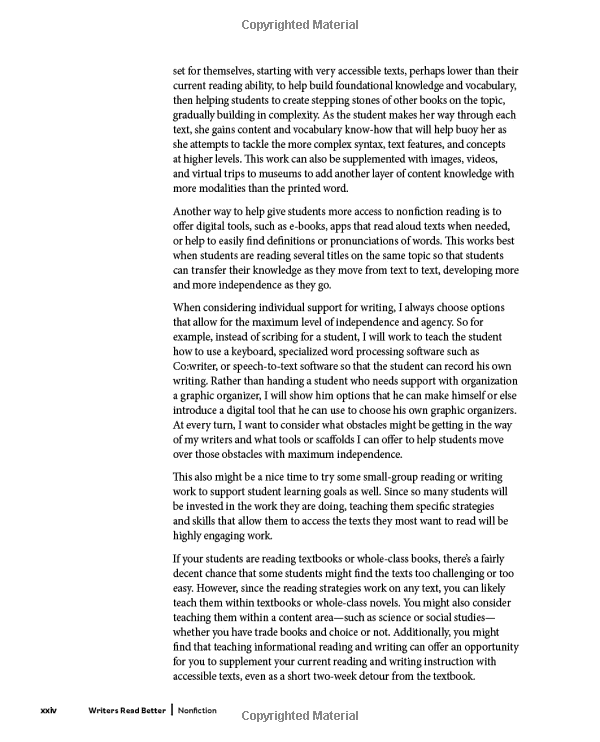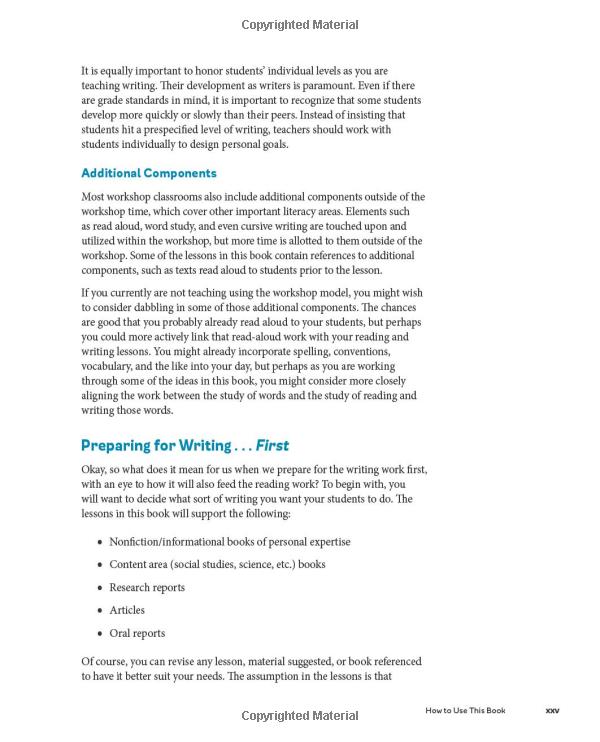图书简介
By flipping the traditional "reading first, writing second" sequence, this innovative book lets teachers make the most of the writing-to-reading connection via 30 carefully matched lesson pairs.
List of Videos \\ Acknowledgments \\ Introduction \\ How to Use This Book \\ PART 1. LESSONS FOR GENERATING IDEAS—AND INTERPRETING AUTHOR’S PURPOSE \\ What You Will Find in This Section \\ When to Use These Lessons \\ Preparing to Use the Lessons \\ LESSON 1 \\ Writing: An Author’s Expertise Matters \\ Reading: Considering the Source \\ LESSON 2 \\ Writing: Write About What You Take for Granted \\ Reading: Learning Unexpected Things From Familiar Topics \\ LESSON 3 \\ Writing: The Relationship Between an Author’s Passions and Stance \\ Reading: Identifying an Author’s Stance \\ LESSON 4 \\ Writing: Narrowing Down a Broad Topic \\ Reading: Understanding Topics and Subtopics \\ LESSON 5 \\ Writing: The Role of Structure in Informational Texts \\ Reading: Considering How Choices in Structure Affect Meaning \\ LESSON 6 \\ Writing: Using Structure to Convey the Writer’s Intent \\ Reading: Inferring the Author’s Intent by Noticing Structure \\ FOR DIGITAL CLASSROOMS \\ Writing: Choosing the Best Platform for Your Information and Audience \\ Reading: Considering Why Authors Might Choose Analogue or Digital Mediums \\ PART 2. LESSONS FOR DRAFTING—AND UNDERSTANDING AUTHOR’S CRAFT \\ What You Will Find in This Section \\ When to Use These Lessons \\ Preparing to Use the Lessons \\ LESSON 7 \\ Writing: Drafting What You’re Most Ready to Write \\ Reading: Spotting What’s Most Important to an Author \\ LESSON 8 \\ Writing: Structure Within Sections: Stacking Information \\ Reading: Identifying the Way Information Is Stacked \\ LESSON 9 \\ Writing: Drafting With Placeholders for Later Facts \\ Reading: Using Jots to Note Facts Quickly \\ LESSON 10 \\ Writing: Taking a Draft Break to Research \\ Reading: Noticing the Various Ways Authors Use Quotation Marks \\ LESSON 11 \\ Writing: Drafting With an Audience in Mind \\ Reading: Noticing the Different Genres of Various Publications on the Same Topic \\ LESSON 12 \\ Writing: Drafting in a Mood or Tone That Matches the Content \\ Reading: Noticing When the Tone Doesn’t Match the Topic \\ LESSON 13 \\ Writing: Drafting to Someone Else’s Specifications \\ Reading: Noticing a Publisher’s Approach \\ FOR DIGITAL CLASSROOMS \\ Writing: Fact-Checking Digital Information for Accuracy \\ Reading: Identifying False Information \\ PART 3. LESSONS FOR REVISING FOR POWER, CRAFT, ANALYSIS, AND CRITIQUE \\ What You Will Find in This Section \\ When to Use These Lessons \\ Preparing to Use the Lessons \\ LESSON 14 \\ Writing: Deciding What’s Most Important to Revise \\ Reading: Identifying and Questioning the Author’s Values \\ LESSON 15 \\ Writing: Reordering Information With Intention \\ Reading: Noticing the Effect of Information’s Placement \\ LESSON 16 \\ Writing: Exploring How Writers Weight Information to Signal Import \\ Reading: Looking at Texts to See How Volume Can Signify Importance \\ LESSON 17 \\ Writing: The Power of Story \\ Reading: Switching Strategies When Authors Use Story in Expository Text \\ LESSON 18 \\ Writing: Connections and Disconnections Across Paragraphs and Pages \\ Reading: Tracing Connections and Disconnections in Transitions \\ LESSON 19 \\ Writing: Vocabulary’s Starring Role in Informational Texts \\ Reading: Expecting and Responding to the Subject’s Vocabulary \\ LESSON 20 \\ Writing: The Slipperiness of Facts \\ Reading: Reading With Eyes Wide Open for Bias \\ FOR DIGITAL CLASSROOMS \\ Writing: Adding Dimensions to Writing Through Multimodal Features \\ Reading: Multimodal Readers Prioritize Synthesis \\ PART 4. LESSONS TO PREPARE FOR PUBLICATION AND THE SCHOLARLY STUDY OF TEXTS \\ What You Will Find in This Section \\ When to Use These Lessons \\ Preparing to Use These Lessons \\ LESSON 21 \\ Writing: First and Last Words: Intros and Conclusions That Attract and Linger \\ Reading: Studying an Author’s First and Last Words \\ LESSON 22 \\ Writing: Choosing When to Quote, Describe, or Summarize \\ Reading: Identifying Sources and Considering Their Reliability \\ LESSON 23 \\ Writing: Creating Text Features to Enhance and Add Information \\ Reading: Integrating Text Features Within and Across Texts \\ LESSON 24 \\ Writing: Creating Strong Titles and Subtitles \\ Reading: Titles and Subtitles That Convey Meaning \\ LESSON 25 \\ Writing: The Many Purposes of Paragraphs \\ Reading: Seeing Paragraphs as an Author’s Organizational Tool \\ LESSON 26 \\ Writing: Punctuating With Intention \\ Reading: Looking Across Texts With an Eye to Punctuation \\ LESSON 27 \\ Writing: Using Meaning to Make Smart Spelling Decisions \\ Reading: The Role of Etymology for Readers \\ LESSON 28 \\ Writing: Making Publishing Decisions Based on the Intended Audience \\ Reading: Judging the Effectiveness of an Author’s Decisions \\ FOR DIGITAL CLASSROOMS \\ Writing: Opening and Maintaining a Conversation With Audiences \\ Reading: Responding Digitally to the Texts to Deepen Understanding \\ Publisher’s Acknowledgments \\ Resources \\ References \\ Index
Trade Policy 买家须知
- 关于产品:
- ● 正版保障:本网站隶属于中国国际图书贸易集团公司,确保所有图书都是100%正版。
- ● 环保纸张:进口图书大多使用的都是环保轻型张,颜色偏黄,重量比较轻。
- ● 毛边版:即书翻页的地方,故意做成了参差不齐的样子,一般为精装版,更具收藏价值。
关于退换货:- 由于预订产品的特殊性,采购订单正式发订后,买方不得无故取消全部或部分产品的订购。
- 由于进口图书的特殊性,发生以下情况的,请直接拒收货物,由快递返回:
- ● 外包装破损/发错货/少发货/图书外观破损/图书配件不全(例如:光盘等)
并请在工作日通过电话400-008-1110联系我们。
- 签收后,如发生以下情况,请在签收后的5个工作日内联系客服办理退换货:
- ● 缺页/错页/错印/脱线
关于发货时间:- 一般情况下:
- ●【现货】 下单后48小时内由北京(库房)发出快递。
- ●【预订】【预售】下单后国外发货,到货时间预计5-8周左右,店铺默认中通快递,如需顺丰快递邮费到付。
- ● 需要开具发票的客户,发货时间可能在上述基础上再延后1-2个工作日(紧急发票需求,请联系010-68433105/3213);
- ● 如遇其他特殊原因,对发货时间有影响的,我们会第一时间在网站公告,敬请留意。
关于到货时间:- 由于进口图书入境入库后,都是委托第三方快递发货,所以我们只能保证在规定时间内发出,但无法为您保证确切的到货时间。
- ● 主要城市一般2-4天
- ● 偏远地区一般4-7天
关于接听咨询电话的时间:- 010-68433105/3213正常接听咨询电话的时间为:周一至周五上午8:30~下午5:00,周六、日及法定节假日休息,将无法接听来电,敬请谅解。
- 其它时间您也可以通过邮件联系我们:customer@readgo.cn,工作日会优先处理。
关于快递:- ● 已付款订单:主要由中通、宅急送负责派送,订单进度查询请拨打010-68433105/3213。
本书暂无推荐
本书暂无推荐












